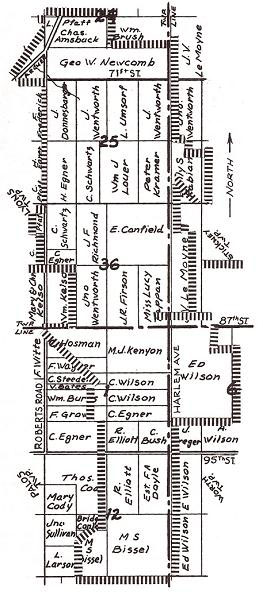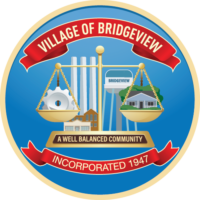History of Bridgeview
Dedication
This section is dedicated to the past Bridgeview historians, Richard J. Pleksa, Anthony J. Ulrich and Edward Blaha, who collaborated in producing the detailed history of Bridgeview’s early years.
How We Became Bridgeview - Setting the Stage
Between 1850 and 1870 Chicago’s population jumped from 30,000 to nearly 300,000. Speculation in land and railroad stock was high. Political subdivision of all Illinois was a result of a compromise between the township system of Northern Illinois and the county system of Southern Illinois. Our state is divided into 102 counties, with each county divided into townships. The present municipal boundaries of Bridgeview include four different townships, with a corner of each meeting at the intersection of 87th Street and Harlem Avenue.
Had it not been for Nathaniel Pope, Representative in Congress for the Territory of Illinois, Bridgeview as well as the entire Chicago area might today belong to Wisconsin. In 1818, Pope persuaded President James Monroe and the U.S. Congress to include Chicago in the new State of Illinois by allowing a wide parcel to be de-annexed from Wisconsin’s southern section.

Subdividing Our Land
The accompanying 1886 real estate map shows the distinctly rectangular pattern of land subdivision and roads. This system of development and settlement was due to the Federal land survey adopted by the government in 1785. It set the pattern for roads and streets, traffic flow, and the arrangement of parcels of land upon which farms and buildings had been developed. Land ownership within the boundaries of what is now Bridgeview followed this rectangular pattern.
The Railroads
The railroad tracks that bisect Bridgeview north and south were laid in about 1884. These tracks were part of a Belt-line system for interchanging cars among the two dozen trunk-line routes that by that time had reached Chicago. The tracks are connected to the Bedford Park Clearing Industrial District, adjacent to Bridgeview. This was an outgrowth of a plan in the 1890’s to develop a large railroad freight classification yard southwest of Chicago. The yard was to extend from 65th to 79th Streets and from Harlem Avenue to two or more miles east. However, construction of the proposed yard was delayed. When the Clearing Yard was finally built utilizing newer methods of railroad operation it was considerably smaller than the original plans. Some of the property along Harlem Avenue, as well as other parcels in Bridgeview, were owned by Long John Wentworth, an early mayor of Chicago. His large estate was at Harlem Avenue and 55th/Archer.
Today, the Belt-line track passing through Bridgeview has been instrumental in bringing industry into our village. Through the efforts of the Village of Bridgeview and railroad company representatives the industrial area along the Belt-line has been developed.
It was due to the proximity of the railroad that sod was removed in the area from 75th to 79th Streets. The sod was loaded on railroad cars from the adjacent land and used at the Columbian Exposition of 1893 in Chicago. Farm horses refused to eat the hay that was grown afterwards in this area because it was too wiry. A further attempt at soil stripping in Bridgeview occurred in 1950, but was defeated by a court action.
Another railroad track ran from 65th Street south along the east side of Harlem Avenue to about 78th Street where it formed a “Y” junction. One leg cut across Harlem Avenue running west on the north side of 79th Street to the Belt-line tracks. The other leg ran east along 79th Street to a brickyard a couple of miles east to Cicero. These tracks show up on aerial photos taken in the 1930’s. Bridgeview resident John Blaha helped in the removal of the rails along Harlem Avenue in 1942. The rails were used for scrap steel for the war effort.
